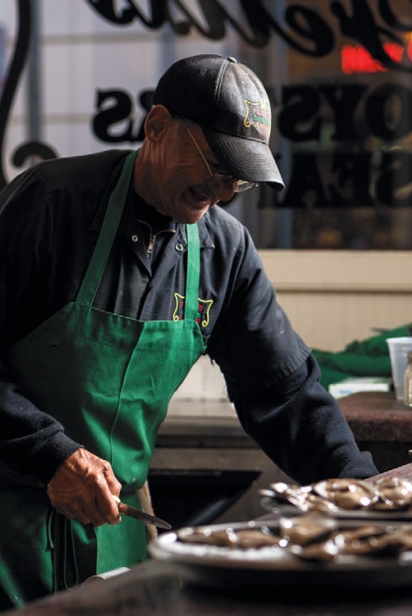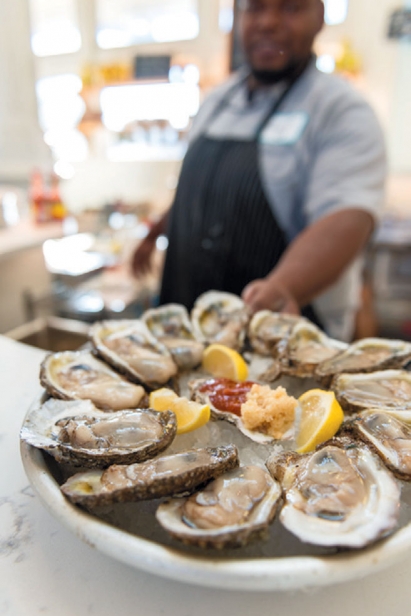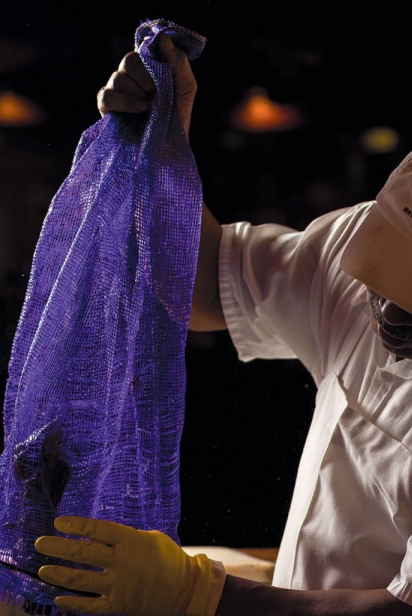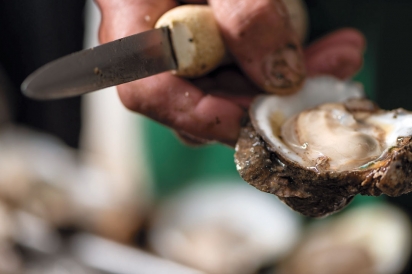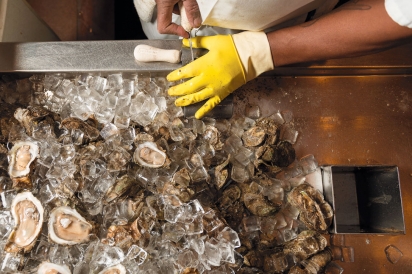Shell Game
Raw skill and flair make the best oyster shuckers
If New Orleans’ heart beats to the rhythm of jazz, then its soul surely dances to the tune of its distinctive palate, with oysters at the head of the line—whether fried, broiled, chargrilled, baked, stuffed into po-boys or raw on the half shell. Five years after the BP oil spill, the beaches have been cleaned and the waters are now clear, but the Gulf Coast and its seafood are still recovering. Even so, Louisiana oysters—plump, meaty and mild—remain arguably some of the best.
I came late to my love of oysters. The idea of a platter of raw oysters on the half shell, on a bed of crushed ice, accompanied by a chilled bottle of champagne, whiling away the afternoon on a sun-filled day sounded luxurious and romantic…but the reality of slurping down a slimy, live organism still swimming in its own juice stopped me in my tracks.
While living in San Francisco many years ago, I visited an oyster farm where I discovered the joys of a freshly shucked oyster: fat with a slightly crunchy bite, and sweet with a slight metallic finish. I felt like I had just tasted the sea, and I fell in love.
Even though I could devour a dozen or more without a thought, shucking an oyster was not something that I could ever get the hang of. The art of shucking requires dexterity, strength and gentleness in equal measures, a balance that has always eluded me.
Whenever I went to a raw bar, I would stare in awe at the oyster shuckers as they rapidly went through the steps—slide in with intent, a quick snap to twist, gently lift top shell, a quick scrape and voilá!—while simultaneously talking, smiling and directing. I would always ask them the same questions: How long have you been shucking? Was there a magical number that when hit, created an expert shucker? What else was involved in the craft of shucking?
“Belly up!” Those were the first words that Paul Dinet said to me as I approached the oyster bar at Felix’s Seafood Restaurant in the French Quarter on a recent Saturday morning. I arrived early just as they opened and were still setting up. Mr. Paul, as he is called, wasted no time in grabbing a gnarly misshapen oyster shell from the pile in front of him and, with barely a glance at his hands, deftly worked his knife into the edge. While directing me to sit and making a joke about me being the early bird, with a flick of the wrist he lifted the top shell, quickly scraped around the meat and presented me with a perfect oyster: silky, meaty and swimming in liquor.
Born in 1933, on the bayou on a houseboat with a midwife, Mr. Paul shucked his first oyster at age 8. His father handed him an oyster knife and showed him the trick to opening the shell, namely: “Find the edge and don’t push too hard. It’s all in the wrist.” They would drive to the river and go digging for oysters, then sit in the back of the truck picking through their catch, shucking and slurping them down raw, the same way that he still prefers to eat them to this day.
At 14, young Paul began working in an oyster factory, earning $10 a day to shuck bags upon bags of oysters. Seventy years of professional shucking, 33 of them at Felix’s, have been difficult on the most important tool that an oyster shucker needs: his hands.
“It can be a dangerous job if you don’t know what you’re doing,” says Mr. Paul reflectively. He shows me his hands, which are marked with nicks, cuts and old scars. “Knives slip and break, shells split off, my hands cramp up, but I just have to keep going.”
At 82 years old Mr. Paul may be the oldest working oyster shucker in New Orleans. Three days a week, he makes his way to Felix’s, takes his place behind the bar, readies his hands and, as he puts it, has “the best time of my life.” When I ask him if speed is what makes a good shucker, he shakes his head and says, “Speed is fun for the customer. They like to see your hands move fast, but what makes a good shucker is accuracy and the quality of the oyster that’s handed to the customer. A clean oyster with no shells and no cuts.”
I spent some more time with Mr. Paul, listening to his stories and watching him as he prepared for the day. He kept me laughing and kept the oysters coming. It was still early, and I wondered how he would keep up the stamina to continue shucking, storytelling and bantering throughout the day. “Eating oysters!” he says laughingly. “I’m not an actor, but I am an entertainer, and the customers come here to be entertained so I have to put on a show.”
I soon leave Felix’s, belly stuffed with oysters, and I make my way to the Curious Oyster Company, a raw bar then located in the St. Roch Market, to meet with Tim Dandridge. (In mid-January, the Curious Oyster Company moved to the Dryades Market on Oretha Castle Haley.) A soft-spoken young man, Tim Dandridge isn’t your typical New Orleans oyster shucker. For one thing, he’s only been shucking for about five years; for another, and unlike most oyster shuckers, he’s quiet and shy and it takes a bit of talking to get him out of his shell, so to speak; and lastly, at 25 years old, he’s young. In the New Orleans oyster shucking world, he’s the ultimate newbie.
Born and raised in New Orleans, Tim came to oyster shucking by circumstance. He was hired to shuck oysters for a party and, having never done it before, he had no idea what to expect. He jumped right in and found that he was not only exceptionally good at it, but also loved doing it.
“I was 17 and had never eaten an oyster before. They just gave me a knife, showed me how to open it once, and I did, and then I ate one—and fell in love with it, and immediately opened up another.” Tim estimated that he probably shucked 1,000 oysters that first day, and he would have happily shucked more. “It makes me feel good, gives me peace of mind. I just start shucking and I go to a quiet place.”
Melissa Marie Martin, chef and owner of Curious Oyster Company, hired Tim on the recommendation of a friend. She needed someone to come in to shuck for a day and called Tim. He showed up 10 minutes later and has been with her ever since.
“Part of what I wanted to create at Curious Oyster was a bar and restaurant with very simple foods to anchor the oysters as your meal. We bring in different varieties of oysters and I needed someone who could speak knowledgeably about the oysters and also be a good shucker. With Tim I have both! He’s the fastest shucker I’ve ever seen.”
“I love eating oysters,” says Tim. “When I come in, I set up and then eat a dozen oysters to jump-start my day.” “I love the flavor, the consistency, the freshness, the wildness. I feel like I can taste the different types of waters. Every oyster tastes different, but my favorite is the Gulf oyster. I love that saltwater swamp taste.”
Tim is young, committed and stresses that the job isn’t about the money. “I work at this oyster bar six days a week, and on the seventh day I go to other oyster bars because I want to see what the other shuckers are doing and how they’re doing it. I’m always looking at their hands because I want to see how they’re shucking, how they’re prying this rock open, to find this beautiful thing in there.”
I leave Curious Oyster Company, head filled with the varieties of oysters they serve, details of which Tim managed to pepper through our conversation. I head Uptown to meet with Thomas Stewart, who mans the counter at Pascal’s Manale. Thomas started in the kitchen in 1986 and would sometimes watch the shuckers as they went about their work. He soon asked them to teach him, found that he liked shucking and made his way from the kitchen to the oyster counter. He’s been there for 25 years.
Thomas is an imposing, tall man with large hands that look as strong as the oyster shells. As we speak, he curls and uncurls his hands repeatedly and frequently cracks his knuckles. I ask him if he was doing hand exercises in anticipation of his evening. “My hands hurt, they always hurt, and I have to warm them up a little before I start.” As I suspected, these guys make it look easy, but it’s not an easy job. “See, the thing is, it’s not just shucking. It’s a performance where you’re involving the people because they’re at the counter. I have to keep talking and interacting with them because I want to keep their attention on me rather than on my hands so that they’re not bored while waiting for their oysters.”
Surprisingly, Thomas isn’t a big fan of oysters, though he estimates that he has shucked hundreds of thousands in his lifetime, at one time shucking nine and a half dozen for one customer. “An old fellow came in one day and just wanted to see how many he could eat, and asked me to keep shucking. So, I did. And we stopped at nine and a half dozen.”
Feats of oyster eating, celebrations or just someone at the end of a long day, oyster shuckers see it all. And much like bartenders, their customers aren’t shy about sharing details of their lives or asking for their advice. “I’ve met so many people doing this job. I have people who come in here and use the oysters as an excuse to come see me and talk to me. People have come in 10 years in between visits and will jump right in with me and remember my name like they had just been in yesterday.”
“I do this for the people,” Thomas continues. “There are many other things that I could do, and some days I leave here and I can barely uncurl my hands, but I keep coming back. I’m going to be doing this for a long time. I like to make the people laugh and I like to talk to them.”
Job or vocation, oyster shucking stands as an art all its own, and oyster shuckers are the anchors. Where in the world can you go, belly up to a bar, order a beer and a platter of raw oysters, have a conversation with a stranger and feel like you’re in your own home? New Orleans.



